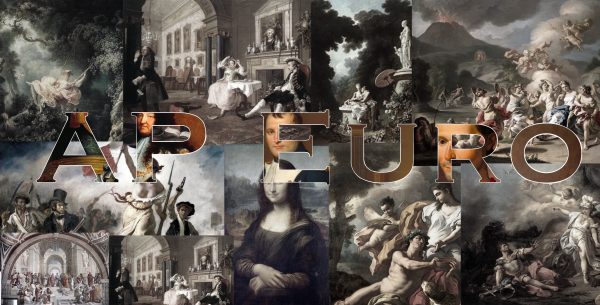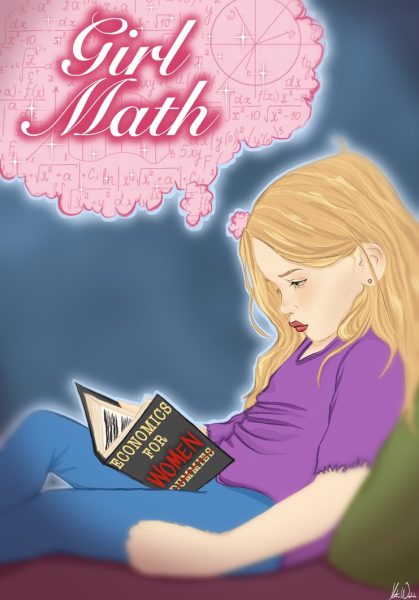Modern Fashion Fading Away
March 1, 2017
The trend of today’s newspapers being filled with little other than Trump-updates is one I’d like to break.
While most Americans don’t associate fashion with politics, the connection between the art form and the political state is undeniable. Much of history’s biggest fashion movements, in fact, trace their roots to acts of cultural and political rebellion. Fashion, unlike America’s current political state, won’t make your head spin, though it will tell you more about society and its changes than you might have expected. Though its stereotypes might tell you otherwise, fashion isn’t just about clothes and accessories. It is infinitely innovative, it comes and goes in different forms through the years, and, like Trump and his clan, can do quite a lot to provoke a national buzz.
Vogue As Society’s Mirror
Most are familiar with Vogue. Arguably the world’s most-famous fashion magazine, Vogue started in 1892 as an illustrative magazine of fashion, and later became a women’s fashion magazine. Its early focus was on portraying society of the time through fashion, but it was never just about pretty pictures of pretty girls.
Vogue’s 1941 issue featured glimpses of WW II because one of their beloved models Lee Miller received official military accreditation as a war correspondent. The issue was filled with beautiful, but terrifying images from the war. No pretty girls wearing pretty clothes, but a real portrait of what the war brought.
Lee Miller’s report after the war ended brought even more significance to Vogue and its readers. Images in her report showed starved and injured soldiers, concentration camp victims, and many other bold images that sparked Vogue’s now long history of effective articles and images.
During 1990 there was a rise in video surveillance in the world when digital multiplexing was discovered. This allowed several cameras to record at once, so streets, shops, banks, casinos, and many other facilities came under surveillance.
This was an inspiration for Vogue’s fashion editor Camilla Nickerson who in 1995 did a photoshoot with model Kate Moss as a girl under surveillance. Photographer Nick Knight took photos of Moss on the street, or in a car as if from a surveillance camera, complete with a surveillance time stamp on each image. This was Nickerson’s presentation of what was new in the world at that time.
In 1995, Nickerson was also inspired by the rise of high heels on runways. She portrayed the dangers of wearing high heels in an editorial High and Mighty with models in heels, and crutches. In an HBO documentary called In Vogue: The Editor’s Eye Nickerson said, “They [heels] are meant to indicate power and stature, and they leave you immobile.”
Teddy Boy
One of the most iconic fashion rebellions was the youth culture of Teddy Boy which emerged in 1950 Britain.
Teddy Boy culture awoke in England during the post-war time when people were encouraged to avoid conflict. Teenagers, at the time only a newly-identified subculture, became inspired by cornerstones of contemporary American culture, such as Marlon Brando and James Dean movies and a new addition to music called rock’n’roll. The proliferation of such movies and music into teenager subculture both in America and overseas came to define teenage rebellion.
Teddy Boy look was introduced by working-class men who parodied the old aristocratic Edwardian look. They wore shoes called creepers, bolo ties, and long jackets, and sported the actor Tony Curtis’ hairstyle with the famous slick sides, and a male pompadour on the top. The dandy, Edwardian looks were probably worn by their grandparents and parents then, so the Teddy Boy look was considered a form of mockery.
Then in 1960 came the rockers, and I’m pretty sure many are already familiar with their look. Black leather jackets, white T-shirts, boots, motorcycles, followed by music of singers like Bo Diddley and Eddie Cochran, and all that good stuff. Journalist Paul Gorman pinpointed this look in TV mini-series Fred Perry presents Subculture. “Rockers were the first to really show that there was a generation gap,” Gorman explained, “because no parent wanted their son to lounge around in oil-covered jeans, great big boots, string vests, and a filthy leather jacket.”
Skinhead
Skinhead, the next fashion rebellion, was definitely the strangest. Skinhead subculture appeared in England during the 1960s. It originated from a mod subculture that was all about being modern and neat. Mods used to wear tailored suits and were inspired by jazz, R&B, and then British bands such as The Who or Small Faces. After the mods and rockers began a sort-of war between them, the mod subculture divided into skinheads and hippies.
Skinheads were an exaggerated version of mod neatness. They wore bigger boots and cut their hair extremely short, but were never racist. In fact, their look was mostly inspired by England’s multicultural beginning when immigration of people of West Indian background increased and brought their subculture called Rude Boy.
First real skinheads combined with this new subculture [Rude Boy] that brought ska music, and polished styles with black jeans, white socks, brogues, and hankies in shirt pockets. Skinhead style was conservative with clean buzzcuts, braces, button up shirts, and an overall cool look.
Today skinhead style gets a bad rap; we connect this term to Neo-Nazis and white supremacist Richard Spencer’s 2 failed attempts of doing an interview without getting punched in the face. Few, however, know where this term actually came from, and that it was the complete opposite of what we know today than when it was first introduced.
Skinhead, before being usurped by white supremacists, was never a racist statement. Ironically, it was actually an example of a successful merge of cultures–British and West Indian–as well as a triumph of the middle and lower classes, as it was an attempt to prove that minimalist working-class is classier than the extremity of upper classes. That it was revived in the 70s by some extreme racists who took the previous look to provoke intimidation has led to an unfortunate and a definitive connotation of this initially diversity and equality promoting movement.
Androgyny
Though our first association with fashion is women, it is interesting that these styles were introduced and encouraged by men. To me, the best invention in fashion is androgyny, where male and female fashion mix.
Androgyny was first pioneered in the 19th century by gender-norm-flouting women such as French novelist and memoirist Amantine-Lucile-Aurore Dupin, better known by her pseudonym George Sand. She wore suits and smoked, activities considered not at all “lady like” at the time.
The flappers who defined the 1920s are an example of androgyny as a fashion rebellion. Flappers shunned tradition, which flaunted and emphasized chests and involved unwieldy layers and limited movement, such as corsets, instead taking to wearing bandages to cover their chests for a more boyish look, and leading careless lives of drinking and partying previously only acceptable for men.
Androgyny continued as a well-represented rebellion throughout the 20th century, seeing actresses such as Katharine Hepburn and Marlene Dietrich wearing suits during the 1930’s Old Hollywood period, as well as the Yves Saint Laurent’s introduction of the “Le Smoking” suit for ladies in 1966.
The music scene incorporated lots of androgyny. From David Bowie as Ziggy Stardust in make-up as well as Mr. Fish man’s dress with the Rolling Stones Mick Jagger to singer Annie Lennox’s buzzcut. Famous designer Vivienne Westwood rocked a short haircut punk look during the 80s when she was inspired by the band Sex Pistols. Designer Jean Paul Gaultier had a photoshoot in an iconic cone shaped corset he made for Madonna in the 90s. It was only the beginning.
Androgynous models are among the most famous models today. Andrej Pejic became well known after having his picture taken in womenswear for Paris Vogue in 2010, and underwent sex reassignment surgery in 2014. She is now known as Andreja Pejic, and regularly walks runways for the biggest brands.
Ruby Rose is also familiar to our generation. She’s an Australian model, actress and musician, who once considered undergoing sex reassignment surgery. She’s known for her androgynous look, and her role in Netflix series Orange is the New Black.
McQueen
Designer Alexander McQueen pushed the envelope for years. One of his first collections was called Highland Rape, and it caused a media frenzy because his fashion show was composed of half naked models in torn up garments. McQueen was inspired by the “ethnic cleansing” by British Forces in the Scottish Highlands in the 18th and 19th centuries, and his older sister who was a victim of domestic violence.
McQueen’s collections were controversial and his shows sold out. Rain on the runway, 2 robots spraying a model in a white dress, models placed inside a torrential wind tunnel, tribute to Hitchcock heroines, and Kate Moss’ hologram are only half of what McQueen’s shows offered. He always had a message behind his collections. He invented 10-inch armadillo shoes, so how can he not be a legend?
Brands Go Big
French designer Gabrielle “Coco” Chanel was born in 1883, and is considered the biggest fashion revolutionary today. She introduced the “little black dress” in 1926 which gave a name to that garment every female has in the closet. She was given the nickname Coco when she worked in a cabaret before opening her first hat shop in 1910.
Chanel was one of the first designers to introduce a fragrance to her brand, and opened a new path to establishment, and income for fashion brands today. Her famous trademarks are the Chanel suits (very uncommon on ladies at that time), striped sailor shirt, quilted Chanel purse, and 2 toned Chanel pump. The reason why her fashion dynasty is still so huge today (lead by designer Karl Lagerfeld) is that she never obeyed trends, but invented her own.
Calvin Klein was criticized for making overly sexualized commercials to promote his brand. The Justice Department came after Klein in early 80s, telling him that photographs of erogenous zones are considered pornography. So, Klein took that opportunity to provoke people with advertisements of model Tom Hintnaus in men’s underwear, and Kate Moss only in jeans and underwear. People responded by breaking through the display cases in order to claim the posters for themselves, and Klein paid the city for damage with great delight. If he hadn’t taken this risk, he wouldn’t be the botoxed millionaire he is today.
Designers Yoshji Yamamoto, and Rei Kawakubo merged Western and Japanese cultures in 1980. Yamamoto helped his mom who worked as a tailor for women, and had always disliked the way they used bright colors, and figures of outfits. Yamamoto and Kawakubo came to the fashion scene of the 80s with quite a different style than the haute couture of that time. Their garments were most commonly black, and oversized, but unbelievably well tailored, and structured.
Coco Chanel, Calvin Klein, Yoshji Yamamoto, Rei Kawakubo, and many other designers never obeyed society’s common rules.
Is Fashion Fading?
All of these subcultures, styles, and trends were inspired by various social and political movements. Today style options are endless, but not new. As I said, fashion is infinitely innovative, but what’s the next fashion revolution going to be? And when?
Will a new style be born out of the current political unrest? Will wearing pink be more than a statement during the Women’s March? If the only fashion inspirations of our generation are Kanye’s Yeezy sneakers, or 5 dollar shoe lace chokers, than it’s safe to say that real fashion is coming to an end.
95-year-old Iris Apfel, has become famous during her old age because of her huge fashion collection, and careless accessorizing. Except for Lady Gaga, it’s hard to find contemporary fashion icons for the young generations of today.
Apfel said, “Fashion you can buy, but style you posses.”
A lot of people don’t like dressing up, but a single pin can be a fashion statement if there’s a story behind it, and a handful of people wearing it.
In Fred Perry presents Subculture fashion designer Wayne Hemingway said,“It [Rude Boy culture] was completely anti the mainstream. Basically, that’s what youth culture should always be. It should always come from being anti the mainstream.”


